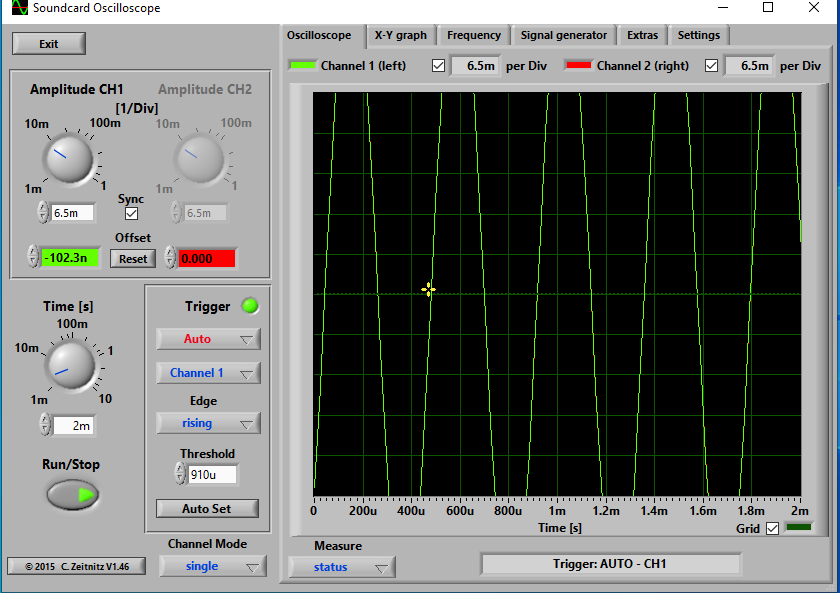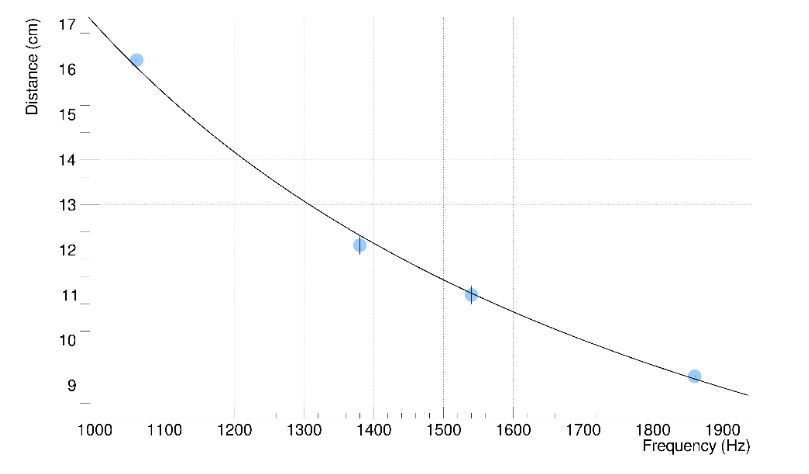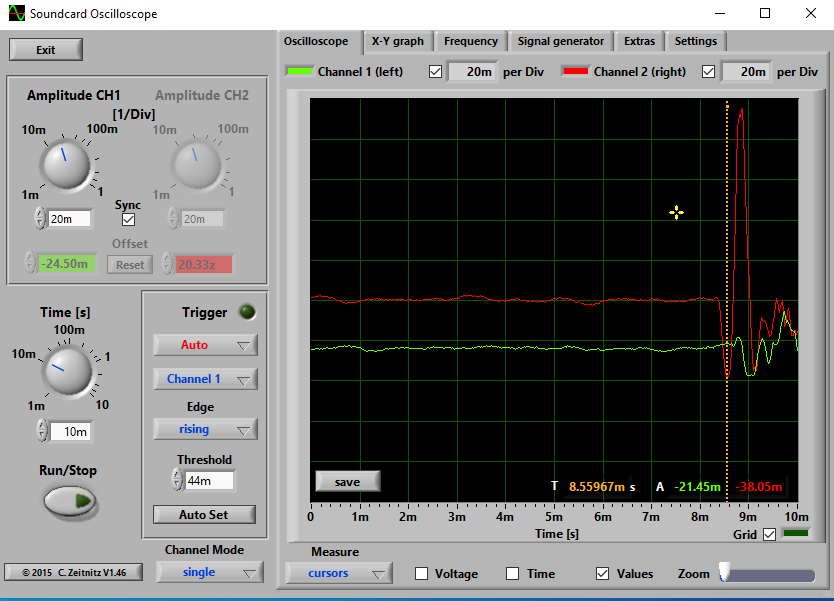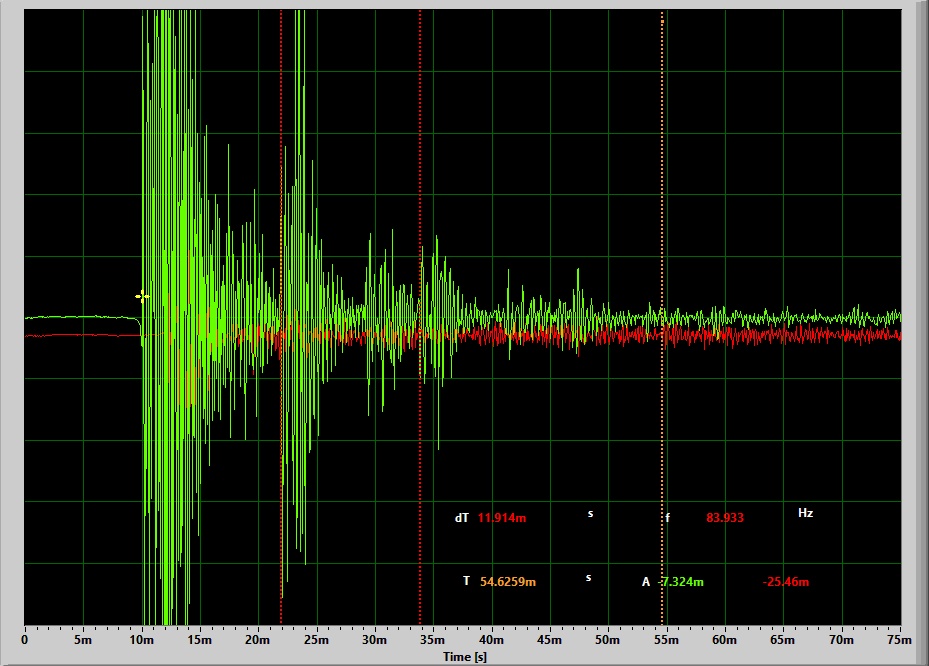3.1 Resonance Tube
3.1.1 Measurements
Lenght of the tube: 1,05 m
| Frequency (Hz) | Distance between nodes (cm) | |||
|---|---|---|---|---|
| Theoretical | Experimental1 | 1st and 2nd2 | 2nd and 3rd3 | Mean4 |
| f13 = 1052,4 | 1060,0 ± 0,8 | 16,0 ± 0,2 | 16,3 ± 0,3 | 16,2 ± 0,2 |
| f17 = 1376,2 | 1380,0 ± 0,8 | 12,5 ± 0,2 | 11,7 ± 0,3 | 12,1 ± 0,2 |
| f19 = 1538,1 | 1540,0 ± 0,8 | 11,1 ± 0,2 | 10,8 ± 0,3 | 11,0 ± 0,2 |
| f23 = 1861,9 | 1860,0 ± 0,8 | 9,5 ± 0,2 | 8,9 ± 0,3 | 9,2 ± 0,2 |

1 The error used correspond to the sum of the uncertainty associated with choosing the correct resonant frequency (0,5 Hz since we could not choose to make steps smaller than 1 Hz) and the difference between the frequency chosen on the phone and detected by the computer (0,3 Hz)
2 The error used correspond to the distance in which is not possible to perceive a change in the wave amplitude
3 The error is greater, since as one advance in the tube, the number of “undesirable” reflections increases, making it more difficult to find the precision position of the nodes
4 The error of the mean was obtained by calculating the propagation of errors (partial derivatives)
3.1.2 Calculations
The fitting function was deduced as follows:
Where is the speed of sound, is the frequency of the sound, 𝜆 is the wavelength of the sound and d is the distance between two consecutive nodes.
In order to maintain consistency between measurement units (distances measured in cm and speed obtained in m/s ), a factor of 100 was added.
+

| Fitting parameters | Fitting function | ||
|---|---|---|---|
| Velocity | Experimental error | Chi - Squared | |
| 340,01m/s | 2,75m/s | 1,98 | |
| Absolute error | Relative error | Experimental error1 | |
| 0,01m/s | 2,94×10-3% | 7,39m/s | |
1 Since the experimental error obtained through the fitting function is smaller than the largest percentage uncertainty of the values used to make the calculation (weakest link rule), a new value was calculated according to it.
Velocity: [332,62; 347,40]m/s
3.2 Two Microphones
3.2.1 Measurements
Lenght of the tube: 1,01 m
| Interval of time (ms) | |
|---|---|
| Attempts1 | Mean2 |
| 3,057 ± 0,250 | 2,920 ± 0,115 |
| 2,920 ± 0,115 | |
| 2,829 ± 0,204 | |
| 3,014 ± 0,240 | |
| 2,990 ± 0,230 | |
| 2,920 ± 0,220 | |
| 2,931 ± 0,226 | |
| 2,947 ± 0,226 | |
| 2,897 ± 0,210 | |
| 2,986 ± 0,230 | |

1 The error used correspond to the sum of half the width of the initial peaks used to calculate the interval of time
2 The error of the mean was obtained by calculating the standard deviation
3.2.2 Calculations
| Velocity | Experimental error1 | Absolute error | Relative error |
|---|---|---|---|
| 345,89 m/s | 13,62 m/s | 5,89 m/s | 1,73% |
Velocity: [332,27; 359,51]m/s
3.3 Echo
3.3.1 Measurements
Lenght of the tube: 2,03 m
| Interval of time (ms) | ||
|---|---|---|
| 1st and 2nd1 | 2nd and 3rd1 | Mean2 |
| 11,800 ± 0,226 | 11,820 ± 0,228 | 11,875 ± 0,108 |
| 11,771 ± 0,226 | 11,721 ± 0,224 | |
| 11,914 ± 0,230 | 11,915 ± 0,230 | |
| 12,029 ± 0,240 | 12,030 ± 0,250 | |

1 The error used correspond to the sum of half the width of the initial peaks used to calculate the interval of time
2 The error of the mean was obtained by calculating the standard deviation
3.3.2 Calculations
| Velocity | Experimental error1 | Absolute error | Relative error |
|---|---|---|---|
| 341,89 m/s | 3,11 m/s | 1,89 m/s | 0,556% |
1 The error of the final result only takes into account time error because its relative uncertainty is bigger than relative uncertainty of measuring the distance (weakest link rule)
